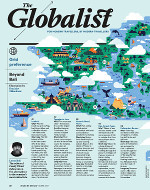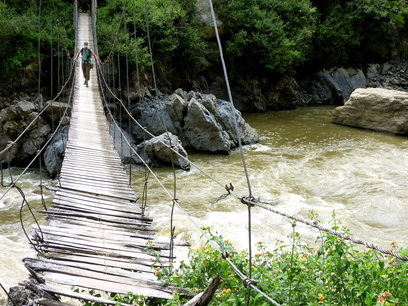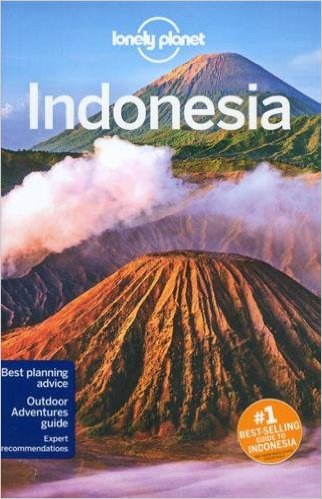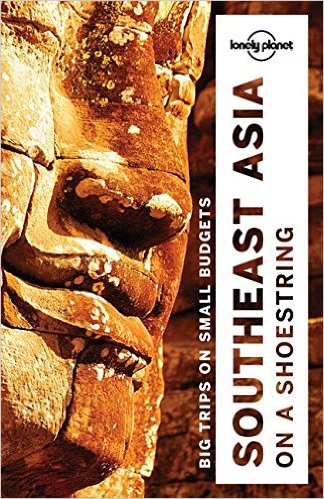
resume
my checkered past
portfolio
written word
development
web, programs and you
contact
contact me
I write features, articles, and essays as well as the occasional travel guide. My work has appeared in Mongabay, The Guardian, and Lonely Planet among others.
Additionally, I provide various editorial services, and develop web-based and desktop applications for non-profit, education, and research programs.
books
featured
-

Bornean orangutan declared ‘critically endangered’ as forests shrink
The Guardian
"This is full acknowledgement of what has been clear for a long time: orangutan conservation is failing."
The Bornean orangutan (Pongo pygmaeus) is now critically endangered according to the International Union for Conservation of Nature (IUCN). This change means that both species of orangutan now face an “extremely high risk of extinction in the wild.”
-

The Globalist: Beyond Bali
Atlas - Etihad Airways
Five alternatives to the country's most visited isle.
-

How to pack light: tips from a master packer
Lonely Planet (Best of round the world travel)
Packing small is essential for any globe-trotter committed to embracing the chaos of travel.
With a small pack, you can chase down your Japanese train as it unapologetically departs on time. You can squeeze in to (or on top of) the only bus to the next village in India. Or, as we learned, when your scheduled speed boat leaves while you are busy bailing your guide out of jail, small packs will allow you to cram six large Americans into a tiny fishing boat to splash your way to your deserted island bungalow in time to watch the sunset.
Of course, packing involves deeply personal decisions. Everyone has their own ideas of comfort and style. But by following a few simple field-tested tenets of travelling small, you can shed size and weight. It might not always save your trip, but it will save your spine and your sanity.
Read more... (external site) -

Borneo Rallies to Reverse a Trend of Fire Destruction
Wildfire Magazine (cover story)
"Hello Mister! 1,000 Rupiah."
A small boy stood in my way as I balanced my motorbike on the planks bypassing a large mud hole. I was running late. A dump-truck hauling oil palm seeds plunged into the quagmire, water splashing over its windshield as it whined up the other side. I paid the equivalent of 10 cents and spun my wheels back to the road. I was on my way to teach a short fire class in the tropical rain forest of Borneo but couldn't get there due to flooding.
Although the annual precipitation in this part of Borneo averages between 4 to 5 meters, there are distinct wet and dry seasons. This was, obviously, still the wet season. Historically, the forests and swamps would lock in the rains like a giant sponge to ride out the dry months. Historically, fire was all but unknown. However, with recent widespread increases in land conversion, all of that is changing. Now, fire is a very real concern for those living on the edge of what is left of the forests — a concern with which they are ill-prepared and ill-equipped to deal.
-

Dodging A(nother) Bullet
Inside/Outside Magazine (cover story)
In the competition for poster-child of the conservation movement, the condor has a hard time competing with the whale, panda bear or Bengal tiger. With its balding, wrinkly head and tendency to defecate on its own legs, the bird does not have quite the sex appeal of other endangered species. But without a doubt, a condor in flight embodies the successes and struggles that come with returning any species to its rightful place in the ecosystem.
And slowly, the sight is becoming more common, with 141 condors now living in the wild and more potentially on the way in Arizona and California. Not bad for a bird that was placed on the endangered species list in 1967 and found only in captivity as recently as 12 years ago. But the condor’s story is far from over, and their greatest ally in their struggle, the average deer and elk hunter, does not even know they pose a threat to the bird’s survival.
-
Killing the Creep
Inside/Outside Magazine
Over 4 million people visit Grand Canyon National Park each year. Most come to take a quick peek into the abyss, snap a few photos and maybe buy a T-shirt. But some come to kill, claiming as many as 70,000 lives a year.
Deep in the recesses of the Inner Canyon, the battles rage. There are no embedded reporters to witness the invasion, and no medals awarded. The combatants travel in small groups in relative obscurity, taking the fight to the enemy invaders. Mostly volunteers on leave from regular jobs, the combatants are fighting for a cause they believe in, seeking no fanfare. Grants and donations finance the effort, and future funding is uncertain. Strange, considering the battle is for the life-blood of the Southwest — WATER — and time is running out.
news / shorter works
-
Indonesia’s five most consequential environmental stories of 2020, Mongabay
-
‘Certified’ palm oil linked to worse social, ecological outcomes for Indonesian villagers, Mongabay
-
New bill could legalize ‘land banking’ by Indonesian plantation firms, Mongabay
-
Orangutan habitats being cleared in areas near palm oil mills, report finds, Mongabay
-
Most communities not seeing promised oil palm payoff in Borneo, study finds, Mongabay
-
Indonesia attack shines a light on controversial road project, Mongabay
-
Bid to protect Borneo’s wild cattle hinges on whether it’s a new species, Mongabay
-
Palm oil supplier to PepsiCo, Mars, and Hershey resumes deforesting in Indonesia, Mongabay
-
In West Papua’s Arfak Mountains, local leaders plot ecotourism boom, Mongabay
-
Study games out oil palm development scenarios in Borneo, Mongabay
-
Debate ensues over British supermarket chain’s decision to ban palm oil, Mongabay
-
Exploring city charms in wide-open Montana, Lonely Planet
-
No Small Potatoes: Boise isn't what you expect, Lonely Planet Magazine
-
How unhealthy is the haze from Indonesia’s annual peat fires?, Mongabay
-
139 scientists shoot down 'misleading' reports from Malaysia peat congress, Mongabay
-
Unclear if France will revisit 'discriminatory' palm oil tax, Mongabay
-
SE Asia's damaged peat swamps could release 8.7 gigatons of CO2, Mongabay
-
Perverse outcomes: Can conservation aid spur deforestation?, Mongabay
-
Study doubles the number of endangered Sumatran orangutans believed to exist, Mongabay
-
New tool seeks end to Indonesian paper giants’ secret links, Mongabay
-
Indonesia’s peat peninsula being drained into oblivion, study finds, Mongabay
-
APP to work with 500 villages to combat deforestation, Mongabay
-
Loss of big animals reduces forests’ carbon-storing capacity, Mongabay
-
A Dayak village campaigns for rights to its forests, Mongabay
-
Indonesia’s indigenous people still suffer human rights violations, says report, Mongabay
-
River flooding to affect 40M people annually by 2030, Mongabay
-
East Kalimantan reaffirms moratorium on new mining, logging concessions, Mongabay
-
Cunning carnivorous plants catch more prey by letting some go, Mongabay
-
Sting operation nets tiger poachers, Mongabay
-
Indonesia dissolves agency charged with forestry reform, Mongabay
-
Communities create timber company to protect Sumatran forest, Mongabay
-
Sulawesi communities build big, unique houses by sustainably managing forests, Mongabay
-
Rapid development threatening traditional farms, forests in West Papua, Mongabay
-
After 10 years vying for protection, Kalimantan community granted legal rights..., Mongabay
-
Sumatran community takes charge to protect its forest, attracts REDD+ attention, Mongabay
-
Sumatran community grows crops, aids conservation through ‘village forests’, Mongabay
-
Sumatran village protects environment through agroforestry, Mongabay
-
Sulawesi village seeks protection for sacred forest threatened by development, Mongabay
-
Forest management by Sulawesi community attracts international attention, Mongabay
-
Sulawesi community regains access to forest on which it depends, Mongabay
-
Child labor and palm oil in Indonesia, Mongabay
-
Indonesia's anti-corruption agency questions former Minster of Forestry, Mongabay
-
Indonesian government slow to reclaim lands damaged by coal mining, Mongabay
-
Black market manta ray bust in Indonesia, Mongabay
-
Human infections by 'monkey malaria' increasing as forests disappear, Mongabay
-
Another mining company found operating in flagrant violation of Indonesian law, Mongabay
-
Tiger traffickers busted in Indonesia, Mongabay
-
Rogue palm oil company appeals deforestation case to Indonesia's supreme court, Mongabay
-
Plantation companies in Sumatra failing to meet fire prevention standards, Mongabay
-
Agam, the adorable baby elephant that captured hearts in Indonesia, is dead, Mongabay
-
Companies hire local communities to evade palm oil restrictions in Indonesia, Mongabay
-
High Court denies appeal by palm oil company that cleared protected peat forest, Mongabay
-
Hitchhiking Caribbean lizard upends island biogeography theory, Mongabay
-
After 12 years, Indonesia finally ratifies transboundary haze agreement, Mongabay
-
Palm oil company continues to operate illegal plantation despite court ruling, Mongabay
-
How Islam could help save Aceh's forests, Mongabay
-
Indonesia to verify ownership of 66M ha of disputed forest land, Mongabay
-
Indonesian authorities bust porcupine-smuggling ring, Mongabay
-
Under pressure over pollution complaints, Aceh calls for closure of gold mines, Mongabay
-
Indonesia to hear indigenous peoples' grievances on land disputes, Mongabay
-
Bali uprising: Plan to convert protected area into golf courses, mall spurs outrage, Mongabay
-
Aceh backtracking on mining moratorium, continues to issue permits, Mongabay
-
Oil palm, mining prompts local govt in Borneo to declare water unsafe for drinking, Mongabay
-
Poachers target elephants, tigers in Sumatran park, Mongabay
-
A letter to Indonesia's new president on his environmental policy, Mongabay
-
Malaysian citizens want govt to spend more to save native rainforests, Mongabay
-
Deforestation drives tigers into contact, conflict with humans, Mongabay
-
Indonesia pledges to protect manta rays, Mongabay
-
Uprising against illegal mining in Indonesia pits villagers against miners, police, Mongabay
-
Study: 59% of Marine Protected Areas are ineffective, Mongabay
-
'Flying snakes' achieve surprising lift through unique body shape, Mongabay
-
Endangered tiger killed in Sumatra, Mongabay.com
-
Through careful management, indigenous people have shaped Asian rainforests for 11,000 years, Mongabay.com
-
One quarter of sharks and rays threatened with extinction, Mongabay.com
-
WALHI Jambi: Forestry giant allegedly evaded $15m in taxes, Mongabay.com
Get the latest at Mongabay
editing
From science journal articles to world exhibitions, I have bludgeoned prose of various states of disrepair into something fit for human consumption.
-
Homes for Plants, Gardens for Humans:
2008 Beijing Olympic Games World Bontanic Garden Exhibition - exhibit
As part of the Green Olympics commitment, the Chinese Academy of Sciences developed an exhibition of world botanic gardens highlighting the importance of plants to humans. Over 40 gardens from 25 countries submitted general information, from which I was solely responsible for developing engaging, informative, and memorable text.
The text was incorporated into an open air exhibit consisting of 50 panels and multiple interactive displays located across from Olympic stadium.
-
I spend much of my time editing research papers for submission to scientific journals for both native English and non-native English speakers. All of which have been accepted for publication in peer-reviewed SCI-listed journals.















